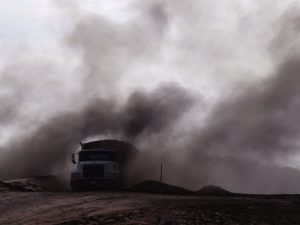
The Environmental Integrity Project and Earthjustice have conducted an analysis of groundwater monitoring data from Oklahoma that recently became publicly available.
Oklahoma City, OK — On the same day EPA Administrator Scott Pruitt decided to allow his home state of Oklahoma to oversee coal ash disposal, a new analysis by Environmental Integrity Project and Earthjustice revealed that all of the dumps containing “coal ash” waste generated by Oklahoma’s coal-fired power plants that tested nearby groundwater found toxic contamination.
The chemicals detected include toxic heavy metals and other substances linked to cancer, neurological damage, and environmental damage. Arsenic, boron, lithium, molybdenum, and radium were among the contaminants found. According to the new analysis, the groundwater fails to meet levels EPA deems safe for drinking water at every coal ash dump in the state that performed the required testing.
Coal ash is a byproduct of burning coal, and too often polluters dispose of it irresponsibly, such as by dumping it in unlined ponds or landfills.
“A takeover by Oklahoma means that a bad situation will get a lot worse,” said Lisa Evans, a former EPA official who is an attorney at Earthjustice and one of the country’s leading experts on coal ash pollution. “States are beginning to line up at Scott Pruitt’s door to shield their toxic coal ash dumps from public health protections. Oklahoma is likely the first domino to fall in a series of states. Oklahoma is an example of how not to handle coal ash pollution.”
The following coal ash pollutants were found at unsafe levels in groundwater at coal ash dumps at these four Oklahoma sites:
- American Electric Power’s Northeastern coal plant in Oologah — Boron, Cobalt, Lithium, Molybdenum, Radium, Selenium and Sulfate
- Grand River Dam Authority’s Grand River Energy Center coal plant near Choteau — Arsenic and Sulfate
- Western Farmers’ Electric Cooperative’s Hugo coal plant in Choctaw County — Boron, Lithium, Molybdenum, Sulfate, Radium and Thallium
- The Big Fork Ranch coal ash landfill in Noble County — Boron and Sulfate
“It’s like asking for a promotion after you have failed every performance review you have ever taken,” said Johnson Grimm-Bridgwater, Director of the Oklahoma Chapter of Sierra Club who testified at the EPA’s hearing on coal ash pollution. “The test results are staggering. The serious water contamination from coal plants that happened right under the State of Oklahoma’s nose is proof that they are not willing to protect their residents from toxic coal ash pollution. Sadly, we have 54 lakes in Oklahoma officially polluted and posted as contaminated with mercury — a direct result of the byproducts of burning coal in our state. Not to mention the poor citizens of Bokoshe, Oklahoma, who can attest to how their waters have been polluted by coal ash.”
“This rampant toxic pollution is proof that state officials are not holding coal plant operators accountable to the people of Oklahoma. These coal plant operators are flouting the state and federal rules, and the politicians are letting them get away with it,” said Earl Hatley, Grand Riverkeeper and LEAD Agency, Inc., who testified at Oklahoma’s hearing against their inadequate state plan, as well as at an EPA hearing near Washington, D.C., on federal coal ash rules.
Having been approved by Scott Pruitt and the EPA, Oklahoma’s rules now allow coal ash landfills and impoundments (ponds) to have permits that last “for life,” meaning they will not be revisited periodically to ensure they are not endangering nearby communities or the environment. In contrast, permits for hazardous waste landfills, air pollution, and wastewater discharges must be renewed at regular intervals — and for good reason. Moreover, under the state’s program, many key decisions about how coal ash dumps are operated would be made behind closed doors, depriving the public of the opportunity to weigh in on whether operators are doing enough to protect Oklahoma communities and waters.
“We are just now getting a glimpse at how widespread the coal ash contamination is in Oklahoma,” said Abel Russ of the Environmental Integrity Project. “The state would like to shove all of that evidence back under the rug, and that would be a big mistake. There is a very basic principle at work here: Oklahoma citizens have a right to know what’s being done to their natural resources. And what about future generations? Dealing with this mess now will be much cheaper than waiting another thirty years, when the problem will be much worse.”
Other states that are reportedly planning to apply for an exemption from federal rules on coal ash include Georgia, Texas, Alabama, Missouri, and Indiana.
“The Oklahoma Department of Environmental Quality publicly admitted that they want state rules that block citizens from suing polluters for contaminating the waters they drink, fish in, and swim in,” said Larissa Liebmann, Staff Attorney at Waterkeeper Alliance. “Oklahoma state officials want to keep their citizens in the dark about what toxic chemicals are being dumped by coal plants. We’re not going to let that happen.”.
The Environmental Integrity Project is a 15-year-old nonprofit, nonpartisan organization, based in Washington D.C., dedicated to enforcing environmental laws and holding polluters and governments accountable to protect public health.
###
Media contact: Ari Phillips, Environmental Integrity Project (202) 538-4728 or aphillips@environmentalintegrity.org


